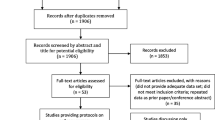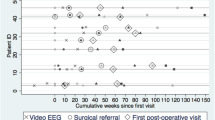Abstract
Purpose
We performed a retrospective analysis of the results of FDG PET scans in children with refractory epilepsy referred to our centre over an 8-year period, with a view to ascertaining the impact of FDG PET on subsequent patient management.
Methods
A questionnaire was used to assess the impact of FDG PET scan on diagnosis, management and clinical decision-making processes for epilepsy surgery from the managing clinician’s perspective. FDG PET scan results were also compared with MRI, EEG and SPECT results and coded according to whether the FDG PET scan provided independent information and localisation of epileptogenic regions.
Results
A total of 118 eligible patients under the age of 14 years were identified, with questionnaires being completed on 113 evaluable patients (96%). The pre-PET management plan consisted of consideration for surgery in 92 patients (81%) and medical therapy for the remaining 21 patients (19%). Managing physicians rated FDG PET as providing information additional to that obtained with other investigations regarding epileptogenic sites in 88 patients (77%). FDG PET had either a minor or a major impact on clinical management in 58 patients (51%), principally with regard to surgical candidacy.
Conclusion
FDG PET has a definite role in the assessment of paediatric patients with refractory epilepsy who are being considered for surgery. In the future, analysis of FDG PET data in specific subpopulations of children with refractory epilepsy may lead to novel insights regarding aetiology.



Similar content being viewed by others
References
Hauser WA, Hesdorffer DC. Epidemiology of intractable epilepsy. In: Lüders HO, Comair YG, editors. Epilepsy surgery. Philadelphia: Lippincott Williams & Wilkins; 2001. p. 55–9
Sander JW. Some aspects of prognosis in the epilepsies: a review. Epilepsia 1993;38:1245–50
Farwell JR, Dodrill CB, Batzell LW. Neuropsychological abilities of children with epilepsy. Epilepsia 1985;26:395–400
Bjornaes H, Stabell K, Henriksen O, Loyning Y. The effects of refractory epilepsy on intellectual functioning in children and adults. A longitudinal study. Seizure 2001;10:250–9
Donner EJ, Smith CR, Snead OC. Sudden unexplained death in children with epilepsy. Neurology 2001;57:430–4
Breningstall GN. Mortality in pediatric epilepsy. Pediatr Neurol 2001;25:9–16
Wyllie E, Comair YG, Kotagal P, Bulacio J, Bingaman W, Ruggieri P. Seizure outcome after epilepsy surgery in children and adolescents. Ann Neurol 1998;44:740–8
Engel JJ. Surgery for seizures. N Engl J Med 1996;334:647–52
Casse R, Rowe CC, Newton M, Berlangieri SU, Berkovic S, Scott AM. Positron emission tomography and epilepsy. J Mol Imag Biol 2002;4:338–51
Salanova V, Markand O, Worth R, Garg B, Patel H, Asconape J, et al. Presurgical evaluation and surgical outcome of temporal lobe epilepsy. Pediatr Neurol 1999;20:179–84
Chugani HT, Rintahaka P, Shewmon DA. Ictal patterns of cerebral glucose utilization in children with epilepsy. Epilepsia 1993;35:813–22
Hamacher K, Coenen HH, Stocklin G. Efficient stereospecific synthesis of no-carrier-added 2-[18F]-fluoro-2-deoxy-D-glucose using aminopolyether supported nucleophilic substitution. J Nucl Med 1986;27:235–8
Won HJ, Chang KH, Cheon JE, Kim HD, Lee DS, Han MH, et al. Comparison of MR imaging with PET and ictal SPECT in 118 patients with intractable epilepsy. Am J Neuroradiol 1999;20:593–9
Gaillard WD, White S, Malow B, Flamini R, Weinstein S, Sato S, et al. FDG-PET in children and adolescents with partial seizures: role in epilepsy surgery evaluation.Epilepsy Res 1995;20:77–84
Gopalan D, Griffiths D, Townsend C, Prvulovich E, Bomanji J, Costa DC, et al. Fluorodeoxyglucose positron emission tomography in clinical oncology: the referrer’s perspective. Nucl Med Commun 2002;23:1041–6
Ryvlin P, Bouvard S, Le Bars D, De Lamerie G, Gregoire MC, Kahane P, et al. Clinical utility of flumazenil-PET versus [18F]fluorodeoxyglucose-PET and MRI in refractory epilepsy: a prospective study in 100 patients. Brain 1998;121:2067–81
Seltzer MA, Yap CS, Silverman DH, Meta J, Schiepers C, Phelps ME, et al. The impact of PET on the management of lung cancer: the referring physician’s perspective. J Nucl Med 2002;43:752–6
Meta J, Seltzer M, Schiepers C, Silverman DH, Ariannejad M, Gambhir SS, et al. Impact of 18F-FDG PET on managing patients with colorectal cancer: the referring physician’s perspective. J Nucl Med 2001;42:586–90
Cartwright A. Professionals as responders: variations in and effects of response rates to questionnaires, 1961–77. Br J Med 1978;2:1419–21
Wyllie E, Comair YG, Kotagal P, Bulacio J, Bingaman W, Ruggieri P. Seizure outcome after epilepsy surgery in children and adolescents. Ann Neurol 1998;44:740–8
Acknowledgements
We would like to acknowledge the contributions made to this study by Dr. Simon Harvey, the staff members of the Centre for PET and the EEG technologists involved in the patient studies.
Author information
Authors and Affiliations
Corresponding author
Rights and permissions
About this article
Cite this article
Ollenberger, G.P., Byrne, A.J., Berlangieri, S.U. et al. Assessment of the role of FDG PET in the diagnosis and management of children with refractory epilepsy. Eur J Nucl Med Mol Imaging 32, 1311–1316 (2005). https://doi.org/10.1007/s00259-005-1844-6
Received:
Accepted:
Published:
Issue Date:
DOI: https://doi.org/10.1007/s00259-005-1844-6




